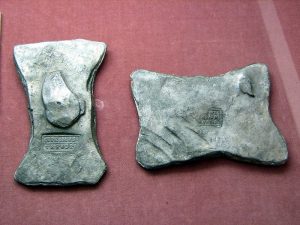Platinum, gold, and the other precious metals described in “Treasure by the Pound” aren’t the only metals lost in treasure hoards. Lead, tin, zinc, iron, and others had significant worth in the ancient and medieval worlds. These metals had a variety of uses, some of which seem shocking today.
Brass: Brass is an ancient alloy of copper and zinc. It is more malleable than bronze, and a low melting point makes it a good candidate for casting. Additionally, its low friction makes it useful for locks and clockwork mechanisms.
Bronze: An alloy of copper, tin, and possibly other elements, bronze was used in weapons and armor until iron made it obsolete. After this point, people used bronze for decorative items such as statues and ceremonial weapons. Historically the ratio of copper to tin in the alloy varied and impurities abounded.
Cold Iron: This fictional form of iron has a special crystal structure that comes from a long cooling period. It is obtained from meteors or the deepest mines and must be worked at low temperatures to preserve its special qualities against fey creatures and demons.
Iron: Iron is both one of the most plentiful metals and one of the most important. Steel, for arms and armor, is produced by adding carbon to the iron during forging. Much of the Vikings’ iron came from bogs—giving a reason for fantasy towns to exist on the edge of troll-infested wetlands.
Lead: Historically people did not know about lead’s toxicity. Its softness made it easy to shape into pipes and cooking vessels. Lead was also used to bind wire with imprinted seals to show that sacks, amphorae, and even the doors protecting King Tut’s mummy had not been opened. If guns exist in the campaign, then the value of lead might triple from 5 gp to 15 gp per pound.
Mercury (Quicksilver): Many people considered mercury, a liquid at room temperature, to have mystical properties. Like lead, mercury’s toxic effects were not understood, and it became a key ingredient in medicine, cosmetics, and alchemy. Occasionally, the very wealthy had decorative pools or fountains of mercury. When traded, earthenware or iron containers held the mercury.
Mercury pools make a natural focus for scrying and divination spells. Additionally, mercury forms amalgams with metals, other than iron, and is thus helpful in gold mining. A character with access to mercury might receive a +2 bonus to Profession (miner) checks.
Tin: Tin, as a key ingredient in bronze, was a critical resource in the ancient world. Oxhide ingots made long-distance transport easier.
Zinc: Historically zinc was alloyed with copper to make brass. There are rare examples of zinc being used on its own in statues and other decorative items.
Table 1 shows the value of these metals in a game world. The lack of real world data and standard fantasy economy of 10:1 relating copper, silver, gold, and platinum prevents any historically based pricing for these metals.
Table 1: Metal Values
|
Metal |
Value per Pound |
| Brass | 7 sp |
| Bronze | 1 gp |
| Cold Iron | 2 sp |
| Iron | 1 sp |
| lead | 5 sp |
| Mercury | 8 gp |
| Tin | 2-1/2 gp |
| Zinc | 1 gp |
More Ingot Types
Bar Stock: Many smiths lacked the equipment to melt iron ingots and cast them into shapes convenient for forging. So, they bought iron as bar stock in lengths of 3, 5, 10, or more feet, and a variety of small cross sections.
Halfer: A halfer was a standard weight lead ingot, rather than a standard size. In terms of campaigns, these ingots came to be called “halfers” because they were about the weight of a halfling, or 30 pounds. In game worlds where halflings weigh more, a lead trade bar might be synonymous with halfer, instead.
Pig Iron: Multiple iron or lead ingots were sometimes cast together by connecting them with a channel, like the sprue used on modern models or miniatures. The resulting ingots were said to resemble pigs suckling, thus the name pig iron. The term pig iron can also refer to unusable iron slag that results from smelting.
Table 2: Common Ingots
|
Ingot |
Value (GP) |
Weight (lbs.) |
Size (in.) |
| Lead Trade Bar | 35 | 70 | 3 x 5 x 12 |
| Lead Halfer | 15 | 30 | 2 x 4 x 9 |
| Lead Piglet | 10 | 20 | 2 x 4 x 9 |
| Tin Trade Bar | 113 | 45 | 3 x 5 x 12 |
| Tin Oxhide Ingot | 184 | 73-1/2 | 26 x 16 x 1 |
| Zinc Trade Bar | 44 | 44 | 3 x 5 x 12 |
| Iron Piglet | 2 | 20 | 2 x 4 x 9 |
| Iron Sow | 5 | 50 | 2 x 6 x 15 |
| Cold Iron Sow | 10 | 50 | 2 x 6 x 15 |
| Iron Bar Stock | 8-1/2 sp | 8-1/2 | 1/2 x 1/2 x 10’ |
| Cold Iron Bar Stock | 8-1/2 sp | 4-1/4 | 1/4 x 1 x 5’ |


This is fantastic!
Awesome! :)
This is darn useful. I have a place for these in an upcoming adventure: thanks for compiling such a great reference.
Thanks for this info! You guys are great
Thanks for the feedback guys! I’d love to hear how you use these in your games.
Good follow up Steve.
Great follow up, Steven.
I used already before similar list(s) either for treasures, ship cargo or merchant caravans or to stock a fortress. The use is manifold and this is why I like such lists.